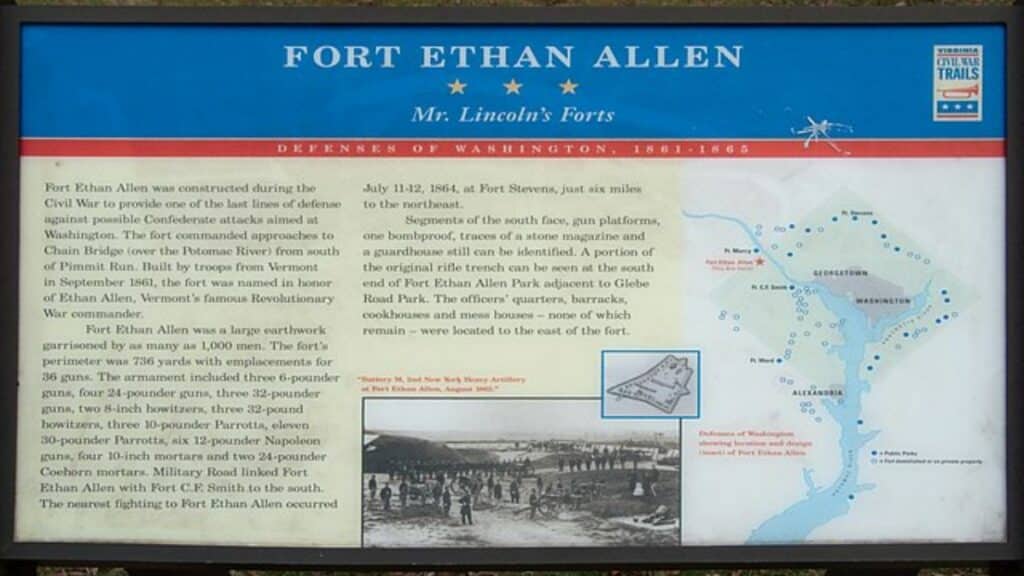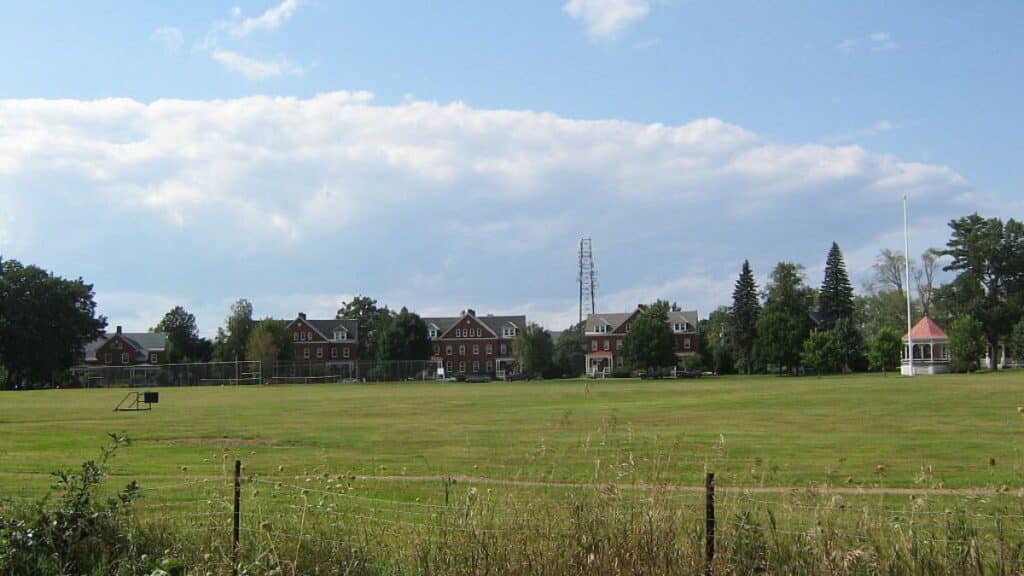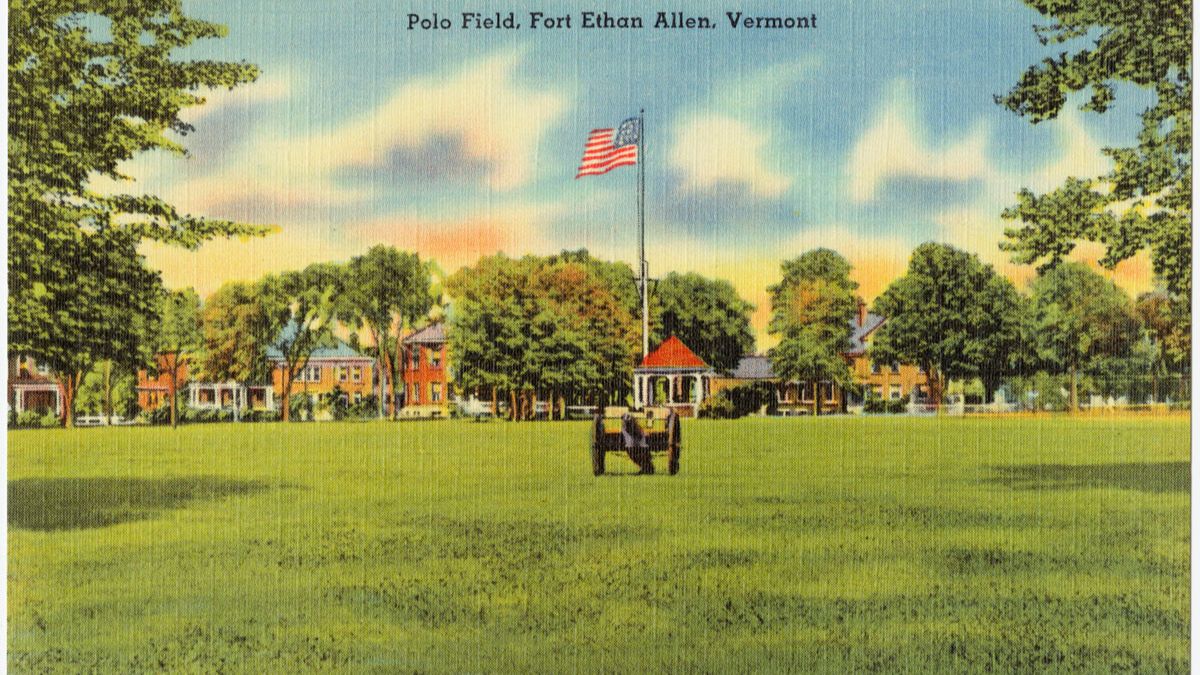Fort Ethan Allen is a pillar of historical significance and community activity located in the heart of Vermont.
Initially established in the late 19th century, this site has evolved from a bustling military installation into a neighborhood affluent with historical charm and modern amenities.
Visitors to Fort Ethan Allen can explore a variety of preserved buildings that offer a glimpse into its military past.
The former barracks and officers’ quarters vividly depict a bygone era. Today, these structures serve new purposes, blending history with contemporary use.
Vermont’s picturesque landscape enhances the appeal of Fort Ethan Allen, providing a scenic backdrop for the fort’s historic structures.
The site also boasts green spaces and recreational facilities, drawing history enthusiasts and outdoor lovers alike.
History of Fort Ethan Allen (Vermont)

Fort Ethan Allen has played pivotal roles during various periods in American history, including the Colonial and Revolutionary Periods, World War II, and the Postwar era.
Colonial and Revolutionary Period
Fort Ethan Allen was a strategic military site during the Colonial and Revolutionary periods.
In the American Revolutionary War, it provided a defensive position for the United States Army. The fort’s location was vital for supply routes and troop movements.
The establishment of Fort Ethan Allen in this era was crucial for protecting settlers and supporting military campaigns against British forces.
It connected various outposts, ensuring communication and coordination. Its presence also deterred British advancements, contributing to American success in securing independence.
World War II and Postwar History
Fort Ethan Allen became a significant training ground for soldiers in World War II. It housed units of the National Guard and was extensively used for military exercises.
The fort’s infrastructure was expanded to accommodate the increased demand for troops and training facilities.
Following the war, Fort Ethan Allen continued to play an important role. It became a base for the Buffalo Soldiers, a historic African American regiment, and supported various military operations.
The fort eventually transitioned from an active military site to a community landmark, preserving its historical importance while adapting to new roles.
Architecture and Structures

The architecture spans various styles and functions, providing insight into its operational history and current uses.
Military Buildings and Barracks
Fort Ethan Allen in Vermont features a mix of military buildings, civilian adaptations, and structures under historic preservation efforts.
Fort Ethan Allen originally housed multiple barracks, stables, and other essential military structures.
Barracks lined the Parade Ground, constructed with sturdy brick to withstand the Vermont climate. The architecture often borrowed from the Colonial Revival and Romanesque styles.
Officers Row included well-crafted quarters with intricate designs. The Riding Hall, used for equestrian training, showcased the era’s functional yet elegant military construction.
Civilian Conversions and Uses
After military operations ceased, many buildings found new purposes.
Barracks and other structures were converted into condominiums and a nursing home. Officers Row homes are now residential properties, maintaining their historical facade.
The old Tailor Shop has become a community space, while the Church serves the residents in new capacities. These conversions preserved the historical integrity while providing modern amenities.
Registry and Preservation
Many buildings at Fort Ethan Allen are listed on the National Register of Historic Places, ensuring their preservation.
Efforts are taken to maintain the original brick exteriors and architectural details. Specific guidelines govern renovations to keep the historical aesthetics intact.
Organizations and local governments collaborate to ensure the Parade Ground, Officers Row, and other structures remain iconic landmarks. Regular assessments and maintenance work contribute to this preservation.
Fort Ethan Allen as an Educational Center

Fort Ethan Allen in Vermont has played a significant role in education through its connection with the University of Vermont and Saint Michael’s College.
Both institutions have utilized the site for various educational purposes, offering a unique blend of historical context and academic resources.
The Role of the University of Vermont
The University of Vermont has integrated Fort Ethan Allen into its educational framework. It uses the site for courses, research projects, and community engagement activities.
Historical buildings are repurposed for classrooms and lab spaces, providing students with hands-on learning opportunities.
The fort’s rich history serves as a backdrop for history, archaeology, and environmental science studies. Students can explore the past while gaining practical skills.
Collaboration with local organizations also enriches the educational experience, promoting a comprehensive learning environment.
Saint Michael’s College Involvement
Saint Michael’s College has also leveraged Fort Ethan Allen for educational purposes. The college offers specialized programs that utilize the site’s unique assets.
Courses in the humanities, social sciences, and natural sciences often incorporate the fort’s historical elements.
Field studies and internships are common, allowing students to gain real-world experience.
The college also hosts community events and lectures at the fort, making it a hub for educational and cultural activities. This integration helps to foster a strong connection between students, faculty, and the local community.
Community and Lifestyle

Fort Ethan Allen, located near the Burlington area, hosts a vibrant community with various amenities and cultural events. Despite its historical roots, it offers modern conveniences and a unique residential experience.
Residential Life and Housing
The residential life at Fort Ethan Allen provides a mix of historic charm and modern living.
The structures originally built for military personnel now serve as unique residences, offering various housing options.
Apartments and single-family homes are prevalent, featuring high ceilings and large windows.
Residents benefit from quiet, tree-lined streets and expansive green spaces. Proximity to Colchester and Essex ensures easy access to additional housing options, shopping, and dining.
Local Businesses and Amenities
The local business scene caters to the community with essential services and enjoyable amenities.
Small businesses, including cafes and boutiques, contribute to the area’s unique character.
A movie theater offers entertainment options, while convenient commuting routes provide access to Burlington’s larger commercial hubs.
Necessities are met with grocery stores and healthcare facilities nearby, ensuring residents don’t have to travel far for daily needs.
Events and Cultural Significance
Fort Ethan Allen is not just a place to live but a community with rich cultural significance.
Regular events like farmers’ markets and art fairs foster community spirit. The Vermont Youth Orchestra occasionally performs, bringing high-quality music to the area.
Historical tours and reenactments celebrating the Fort’s past are popular. Festivals and seasonal celebrations enhance the social fabric.
Proximity to Vermont Public cultural programming further enriches residents’ cultural experiences.
Military Operations and Training

Fort Ethan Allen in Vermont has played a crucial role in various military operations and training activities. It has facilitated the development and readiness of multiple military branches through several historical periods.
Cavalry and Field Artillery
Fort Ethan Allen initially served as a cavalry and field artillery unit training base.
From its establishment in the 1890s, the fort trained cavalry troops in horsemanship, tactical maneuvers, and marksmanship. The cavalry units stationed here prepared for rapid deployment and reconnaissance missions.
Field artillery units received in-depth training in the use of cannons and other artillery pieces.
Soldiers were rigorously trained in targeting, firing, and battlefield coordination. Notably, General Leonard Wood, a key figure in the U.S. Army, oversaw some of these training operations, enhancing the fort’s strategic importance.
National Guard and Air Force
The Vermont National Guard has a long-standing presence at Fort Ethan Allen. This section trained National Guard troops for various state and national duties.
From disaster response to homeland security, the fort has been instrumental in ensuring that the Vermont National Guard remains prepared for any situation.
The Air Force also utilized the fort during the mid-20th century.
Training for Air Force personnel included basic military training and specialized instruction in air operations.
The fort provided a comprehensive training ground, enabling readiness for traditional and modern military engagements.
Cold War and Modern Services
Fort Ethan Allen was a critical site for training and preparedness during the Cold War.
The focus was on anti-aircraft artillery and preparing troops for potential conflicts with global adversaries. The fort’s infrastructure adapted to support advancements in military technology and tactics.
The fort has been repurposed for modern military services in recent years.
Fort Ethan Allen supports training exercises for the National Guard and Air Force, ensuring readiness for contemporary security challenges.
Its legacy lives on through its ongoing contribution to military preparedness and national defense.
Post-Military Transition
After Fort Ethan Allen was decommissioned, the focus shifted to repurposing the land and buildings to serve new purposes that benefit the community.
Privatization and Redevelopment
Following its closure, the Federal Government transferred control of Fort Ethan Allen to the General Services Administration. Portions of the property were sold off to private developers.
The State of Vermont played a significant role in this transition, coordinating efforts to ensure the land was utilized effectively.
The redevelopment included converting old military housing into residential units and office spaces. Historic buildings were preserved and repurposed, maintaining the fort’s historical essence.
This effort has successfully integrated the fort into the local community, providing housing, employment, and commercial opportunities.
Modern Use of the Grounds
Today, the grounds of Fort Ethan Allen serve various purposes.
The state and local entities have ensured that sports fields, community centers, and parks are accessible to the public. These spaces support local events and recreational activities, strengthening community ties.
Several buildings are now used by local businesses and organizations, contributing to economic growth.
The site also hosts historical tours and educational programs, highlighting its significance in American military history. These transformations illustrate how the fort has been effectively repurposed to meet contemporary needs.
Cultural and Museum Exhibits
Fort Ethan Allen is home to significant cultural and museum exhibits that provide a deep look into its history. These exhibits include the renowned Fort Ethan Allen Museum, which strongly focuses on artifact preservation.
Fort Ethan Allen Museum
The Fort Ethan Allen Museum allows visitors to explore the fort’s history and notable events.
It features a range of displays, including military artifacts, photographs, and documents from different periods.
Museum curators ensure that exhibits provide a chronological narrative of the fort’s development and its role in defense.
Oral histories from veterans and residents are presented through multimedia displays, adding personal insights and depth to the museum experience.
Artifact Preservation
Artifact preservation is critical to Fort Ethan Allen’s cultural heritage efforts.
The museum is dedicated to maintaining and restoring artifacts that provide insight into the daily lives of those who lived and served at the fort.
Preservation techniques include climate-controlled storage, professional conservation treatments, and detailed records of each item’s history.
The collection includes uniforms, weapons, personal items, and other materials critical to understanding the fort’s history.
The aim is to protect these treasures for future generations to enjoy and learn from.
Explore More: 10 Historic Forts in Vermont: An Amazing Historical State
Infrastructure and Daily Life
Fort Ethan Allen in Vermont was a hub of activity and functionality. Its infrastructure supported military operations and residents’ daily lives, incorporating essential utilities, support buildings, and agricultural resources.
Support Buildings and Utilities
The fort contained a variety of buildings vital to daily operations.
The Water Tower was a key structure, ensuring a steady water supply.
Medical services were provided at the Hospital, treating routine and emergency health needs.
Communication needs were met by the Post Office, a central spot for sending and receiving mail.
Religious services and community gatherings took place in the Chapel, which doubled as a venue for various events.
Physical fitness and training occurred at the Gymnasium.
Stored arms and munitions were kept in the Armory, a secure facility.
Utilities like the pump house supplied water, while coal storage buildings ensured heating fuel.
Hay storage also supported cavalry units. The Drill Hall was used for training exercises and large community gatherings.
Agricultural and Natural Resources
Agriculture played a significant role at Fort Ethan Allen.
Farmland around the fort supported livestock and crops, providing food for the resident population.
The fertile land by the Winooski River was incredibly advantageous for irrigation and farming.
These agricultural activities sustained the fort and helped in self-sufficiency during limited external supplies.
The community’s use of natural resources allowed it to thrive, leveraging the land and the river.
The integration of agricultural practices highlighted Fort Ethan Allen’s ability to support itself economically and logistically.

Cory is a website owner and content creator who enjoys fishing, history, coin collecting, and sports, among other hobbies. He is a husband and father of four.
Romans 15:4 For whatever was written in former days was written for our instruction, that through endurance and through the encouragement of the Scriptures we might have hope.

